Pacific Tsunami Museum Anchors Hilo Waterfront
The Pacific Tsunami Museum in Hilo has a refreshed outlook after a major project was completed in Spring 2023.
“Restoration of the Pacific Tsunami Museum building generates community pride. Staff members, visitors, residents, and nearby business owners have positively commented on the building’s improved overall look and condition,” wrote Joshua Bell, Associate Director.
The signature building at 130 Kamehameha Avenue fronts Hilo Bay. It was designed by C.W. Dickey in 1930 as Bishop National Bank, later First Hawaiian Bank. The former bank building withstood the disastrous tsunami waves that hit Hilo in 1946 and 1960.
Architectural historian Don Hibbard described the building as, “Hawaiian Classical Revival at its most commanding, this reinforced-concrete, former bank building is clad in cast stone, manufactured on-site by Mario Valdestri. Its Hawaiian interpretation of classical forms includes distinctive coconut husk column capitals. The wrought-iron grillework above the entrance reveals an Art Deco influence” (Buildings of Hawai‘i, 2011).
On May 22, 1997, First Hawaiian Bank donated the building to serve as a permanent site for the museum. By June 1998, the Pacific Tsunami Museum was open to the public.
The Museum operates with the mission that through education and awareness, no one should ever again die in Hawai‘i due to a tsunami. It provides residents and visitors to the State of Hawai‘i with tsunami education programs by showcasing a series of permanent exhibits that interpret tsunami phenomena, the Pacific Tsunami Warning System, the history of tsunamis in the Pacific Basin, and public safety measures for tsunami disasters.
“Efforts to restore and preserve the building are particularly important to the Pacific Tsunami Museum, as its historic exteriors lends to the museum’s mission of sharing of our local history to promote tsunami awareness,” Bell explained.
 Since its original rehabilitation, the building experienced several issues. With the support of Historic Hawai‘i Foundation’s Hilo Preservation and Beautification Program, the Museum accomplished several major outcomes.
Since its original rehabilitation, the building experienced several issues. With the support of Historic Hawai‘i Foundation’s Hilo Preservation and Beautification Program, the Museum accomplished several major outcomes.
“The PTM Exteriors Preservation 2021 project has resolved specific safety issues for the Pacific Tsunami Museum,” Bell explained. “Falling concrete and broken windows have been repaired and the installation of gates provide a certain level of safety not only from vandalism but also contributes toward the personal safety for our museum staff and guests.”
The project included:
- Concrete spall repairs on the Kamehameha Avenue and Kalakaua Street elevations, removing damaged and fragmented pieces of concrete, preparing damaged concrete and rebar for spall repair, rebar protective treatment, formwork for spall repair, and staining repaired spalling to match existing wall colors to preserve the building’s historic appearance.
- Entrance step repair of broken concrete and replacing the cracked and aged tile steps with new ceramic bullnose tile to match the original color as closely as possible.
- Exterior railings were professionally cleaned, primed, and repainted black to restore appearance and promote longevity.
- Landscaping with tree trimming and hauling of green waste. Old gravel and debris was cleaned up and replaced with clean gravel.
- Soft washing of all exterior walls and entrances and gutter cleaning to clear water buildup, plant growth, and further wall discoloration.
- Fabricated and installed custom metal lockable gates at the Kamehameha Avenue and Kalakaua Street entrances.
- Replacement of museum signage, keeping to the original design and colors and restored the signs’ original mountings.
- Window glass replacements of two large windows that had cracked.
- Replacement of historic iron screen that matched the original design above PTM’s Kamehameha Avenue doors.
“Bell said that the project was able to provide work for over ten local contractors and vendors. “The Pacific Tsunami Museum coordinated the project with numerous locally-owned businesses located on Hawai’i Island. Working with these vendors was also useful in establishing new relationships leading to win-win partnerships, for example, exchanging the installation of small business signage for complimentary landscaping. The project brought opportunity and awareness to begin planning for possible future roof repairs,” he said.”
[/fusion_testimonial][/fusion_testimonials]




